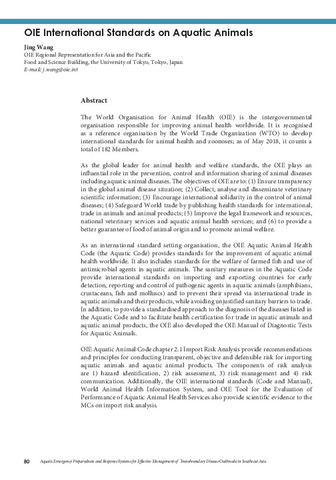Fish disease control in Japan
- Global styles
- MLA
- Vancouver
- Elsevier - Harvard
- APA
- Help

Date
2019Author
Page views
14,224ASFA keyword
disease control 
disease recognition
disease resistance
disease transmission
epidemiology
husbandry diseases
aquaculture regulations
quarantine regulations
policies
fishery policies
safety regulations
fish diseases
public health
food safety
fisheries
fish
workers
watersheds
training
laboratories
animal diseases
fish culture
aquaculture
resource conservation
methodology
animal products
vaccines
research
antibiotics
aquatic animals

disease recognition

disease resistance

disease transmission

epidemiology

husbandry diseases

aquaculture regulations

quarantine regulations

policies

fishery policies

safety regulations

fish diseases

public health

food safety

fisheries

fish

workers

watersheds

training

laboratories

animal diseases

fish culture

aquaculture

resource conservation

methodology

animal products

vaccines

research

antibiotics

aquatic animals

AGROVOC keyword
Metadata
Show full item record
Share
Abstract
The regulatory authority responsible for the control of aquatic animal diseases in Japan is the Animal Products Safety Division, Food Safety and Consumer Affairs Bureau, Ministry of Agriculture, Forestry, and Fisheries (MAFF). The ministry (Animal Products Safety Division) specifies certain diseases and their host species that are subjects for import quarantine on the basis of the law called Fisheries Resources Protection Act. The MAFF also implements risk control measures for the same diseases within Japan on the basis of another law, Fish Farming Production Maintaining Act. Currently, 24 such diseases are listed. For disease control within Japan, the MAFF issues Guideline for the Control of Aquatic Animal Diseases, which states the roles of different stakeholders, appropriate actions that are to be taken on the occurrences of specified or other diseases, fish health guidelines for fish farmers, or diagnostic methods for specified diseases, etc. Local prefectural governments in Japan are required to place personnel who work on fish health issues at the prefectural fisheries research laboratories. These people usually inspect fish farms, observe cultured aquatic animals, supervise the use of antibiotics or vaccines, and guide fish farmers for disease control. Disease diagnosis for aquatic animals is usually conducted by these local fisheries research labs for free. The Japan Fisheries Resource Conservation Association provides a comprehensive training course on fish diseases including laws or hands-on trainings for the staff of prefectural fisheries research laboratories. The JFRCA also give local fish health personnel the qualification as the fish health expert, if the person passes the examination conducted after the training course. Primary diagnosis for specified diseases is conducted by local fisheries laboratories. On the occurrence of the diseases that are suspected to be one of the specified diseases or OIE listed diseases that have not been reported in Japan, the samples are sent to the National Research Institute of Aquaculture (NRIA) where confirmatory diagnosis is made. When such diseases are confirmed, it is reported to the MAFF (or to the OIE through MAFF). For specified diseases, Fish Farming Production Maintaining Act enables local governments to implement necessary measures to prevent the disease from spreading, including issuing orders such as to stop the transfer of the animals to other watersheds, to destroy animals, or to disinfect the facilities. When an unknown disease is encountered by a prefectural fisheries research laboratory, the NRIA is requested to conduct diagnosis. The NRIA develops diagnostic methods for new diseases and disseminate the techniques to local fisheries research laboratories. The NRIA provide positive control materials for disease diagnosis, hands-on trainings of specific subjects concerning diagnostic techniques, or proficiency tests for the fish health personnel of the local fisheries research laboratories.
Suggested Citation
Miwa, S. (2019). Fish disease control in Japan. In E. A. Tendencia, L. D. de la Peña, & J. M. V. de la Cruz (Eds.), Aquatic Emergency Preparedness and Response Systems for Effective Management of Transboundary Disease Outbreaks in Southeast Asia: Proceedings of Asean Regional Technical Consultation, 20-22 August 2018, Centara Grand Central Ladprao, Bangkok, Thailand (p. 22). Tigbauan, Iloilo, Philippines: Aquaculture Department, Southeast Asian Fisheries Development Center.
Type
Conference paperISBN
9789719931089
Related items
Showing items related by title, author, creator and subject.
-
Country status of aquatic emergency preparedness and response systems for effective management of aquatic animal disease outbreaks in Myanmar
Oo, Kyaw Naing; Cho, Yi Yi (Aquaculture Department, Southeast Asian Fisheries Development Center, 2019)Myanmar is one of the OIE members and the Department of Fisheries (DoF) is highly concerned with transboundary aquatic animal pathogens. Therefore, the Aquatic Animal Health & Disease Control Section has already been ... -
OIE international standards on aquatic animals
Wang, Jing (Aquaculture Department, Southeast Asian Fisheries Development Center, 2019)The World Organisation for Animal Health (OIE) is the intergovernmental organisation responsible for improving animal health worldwide. It is recognised as a reference organisation by the World Trade Organization (WTO) to ... -
Aquatic emergency preparedness and response system in Viet Nam
Bui, Viet-Hang T.; Nguyen, Viet-Nga T.; Nguyen, Lan-Huong T.; Nguyen, Hien T.; Pham, Quan H.; Vo, Chuong D.; Nguyen, Tien N. (Aquaculture Department, Southeast Asian Fisheries Development Center, 2019)Viet Nam is one of the top worldwide producers of aquaculture products which accounts for about 22 percent of total agricultural GDP of Viet Nam. Recently, diseases have become the biggest challenge for global aquaculture ...




